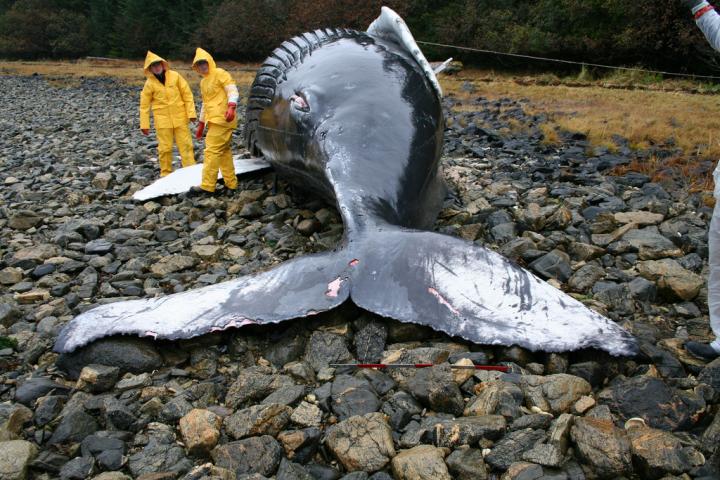Solar storms that disrupt the Earth’s magnetic field may be scrambling gray whales’ internal GPS and causing them to strand on shorelines, a new study found.
Gray whales journey an annual 10,000 miles between the Arctic and Mexico, one of the longest migrations on Earth. They cling to the coastline for most of it, and a brush too close to the shore could lead to a stranding, also called a beaching. Though rare, a stranding can be deadly for whales, since they can collapse under their own weight without water underneath them or drown at high tide.
Videos by VICE
To get a better sense of what causes strandings, scientists studied the conditions on the days of over 100 strandings. Then, they realized something weird: sunspots, signs of magnetic field disturbance, seemed to appear at higher numbers than usual on a day when a whale stranded. The researchers concluded that gray whales may rely on Earth’s magnetic fields to navigate, and that solar storms—which sunspots visually indicate—may be wreaking havoc on their directional senses. They published a study on Monday in the journal Current Biology supporting magnetoreception in whales .
“I felt that we might be able to learn a lot more about this mysterious sense by looking at situations in which an animal actually FAILED to navigate properly,” first author Jesse Granger said in an email. “If we could figure out how animals use the earth’s magnetic field to navigate, potentially, we could do the same and improve the navigation for vehicles where it is essential they travel as efficiently as possible—like ambulances.”
Granger’s team tracked solar activity data for the days of 186 gray whale strandings between 1985 and 2018. They found strandings were 2.3 times more likely to occur on days with a high number of sunspots.
Now, you may be yelling at your screen: correlation does not equal causation! First off, congratulations on taking Statistics 101. But second, there is more to this correlation than meets the eye, and that’s because of space weather.
Just like on this planet, space has weather, too. Changes in the distribution of charged gases on the surface of the Sun create space weather in the form of bursts of energy and reorganizing magnetic fields. These solar storms can interfere with Earth’s own magnetosphere nearly 93 million miles away. Sunspots are a visible sign of intense magnetic activity that contributes to space weather, so the fact that they were correlated with whale strandings hinted at a possible magnetic explanation.
If the Sun does play a role in causing whale strandings, the scientists wanted to know how, exactly, it works. Are the whales simply getting confused, or have the solar storms rendered them navigationally “blind?”
To find out, Granger looked at the relationship between strandings and two other variables: radio frequency (RF) and Ap-index (AP). Solar storms increase RF noise, which is thought to impair the navigational receptors of animals that rely on magnetoreception. AP, on the other hand, told the scientists about the magnitude at which Earth’s magnetic field was changing during space weather. The researchers found that the high mean RF values during strandings were unlikely to be due to random chance, but did not find a similarly significant relationship between AP values and strandings.
“Looking into RF and AP told us that, if this is an effect on a magnetic sensor—which of course we still can’t say for certain—it seems to be that the whales are stranding more often because their magnetic receptor itself is getting disrupted, not that the whales are simply receiving inaccurate information,” Granger said.
Another way to think about it is by comparing the whales’ behavior to getting lost on numbered city streets. Granger said that a relationship between AP values and strandings would have indicated that the whales thought they were on 4th street, when in reality they were on 8th street. The relationship they did find between RF values and strandings suggest that the whales think they’re on 4th street but have actually gone blind, she added.
“This is a really interesting set of correlations,” said Nathan Putman, a senior scientist at LGL Ecological Research Associates, who was not involved in the research. “There’s this nonrandom distribution of whales, and a nonrandom distribution is pretty unremarkable, but the fact that they’re nonrandomly distributed with respect to magnetic stuff may lend some support to the idea that the whales are somehow perceptive of this magnetic information.”
Putman, who studies the movement of marine organisms and magnetoreception, said that humans have found many ways to interfere with magnetic fields and the animals that use them to navigate. For example, studies in turtles show that galvanized iron cages used by conservationists to protect turtles’ eggs from predators end up disrupting their local magnetic fields.
Putman said that there is no direct link between human interference of undersea magnetic fields and whale strandings, but added that humans disturb gray whales by making a lot of underwater noise with explosions and sonar.
Sun storms may not be the entire or only reason for whale strandings, Granger said, and many conditions—both natural and manmade—may contribute to them.
“This is only one possible cause of strandings, among a myriad of other causes, such as mid-range naval sonar, or changing ocean conditions, etc.,” she said. “I am really trying hard to avoid having some military base get ahold of this research and use it as an excuse to start blasting sonar all over the place.”
More
From VICE
-

Screenshot: Nintendo -

Illustration by Reesa.

